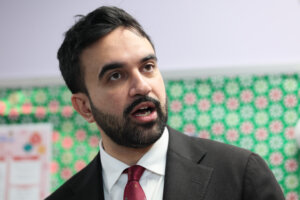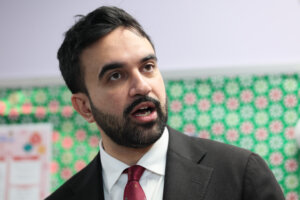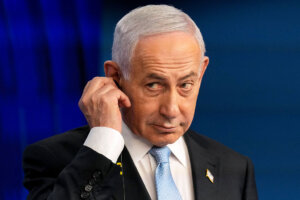Uncategorized
Soviet Jewry protest leaders in San Francisco secretly recruited help from Jews for Jesus, FBI file says
(JTA) – Organizers of protests on behalf of Soviet Jewry in San Francisco in the early 1970s might have bolstered crowds by secretly recruiting participants from Jews for Jesus.
The explosive revelation that Jewish leaders turned to a Christian missionary group for help appears in a 1973 FBI memo that the Jewish Telegraphic Agency recently obtained through a freedom of information request.
The FBI file details an apparent relationship between Martin Rosen, the founder of Jews for Jesus, and Joel Brooks and Harold Light, two prominent San Francisco Jewish leaders at the fore of local efforts in the movement to get Soviet authorities to end restrictions on the emigration of the country’s Jewish population. The relationship outlined in the declassified memo has not appeared in scholarship on the Soviet Jewry movement, nor is it known to activists of the movement who were interviewed by JTA. Light, Brooks and Rosen are deceased.
If the FBI’s intelligence is accurate, a successful and cherished social movement that unified much of the global Jewish community in common purpose for decades relied at least to some extent in San Francisco on the support of a group, rejected by nearly all of that community, whose mission is to proselytize to Jews.
“The first thing I thought of was, I’m reading something from ‘The Twilight Zone’ — in my many years in the Soviet Jewry movement, I don’t know if I’ve seen a document as strange as this,” said Morey Schapira, who served in leadership positions in the Student Struggle for Soviet Jewry, the Bay Area Council for Soviet Jews, and the Union of Councils for Soviet Jews. “The idea of working with a slimy group like Jews for Jesus, it’s beyond my comprehension.”
The public can request any FBI files that may exist pertaining to deceased individuals. An FBI memo relating Rosen arrived last November in response to one of about 50 freedom of information requests on prominent figures in recent Jewish history submitted by JTA almost two years ago. Most of JTA’s requests are still pending. TO DOWNLOAD THE FBI FILE, CLICK HERE.
Dated May 24, 1973, and written by an FBI informant whose name was redacted by staff at the U.S. National Archive, the memo focuses on Brooks, who was the Northern California director of the American Jewish Congress for about 30 years starting in 1967.
“[Brooks] has heavily utilized the services of the young Jews in the Jews for Jesus group,” the informant wrote. “[He] has used these services to turn out people in his Soviet Jewry demonstrations.”
The informant also cites Brooks as saying that Light, leader of the Bay Area Council for Soviet Jewry, used members of Jews for Jesus in a “hush-hush way” to distribute leaflets and participate in demonstrations.
The memo spells out why such an arrangement would be best kept out of the public eye.
“All of this, of course, is secret, because organized Jewish groups, and the various rabbinical councils have proclaimed that Jews for Jesus are no longer Jews but have become apostates, and should not be palled around with, nor buried in Jewish cemeteries,” the informant writes.
Martin “Moishe” Rosen, founder of Jews for Jesus in 1975. (Denver Post via Getty Images)
The upside for Rosen was obvious: His group would gain a foothold in a popular Jewish movement, offering a potential avenue toward legitimacy and a pool of possible recruits. In his 1974 memoir, titled “Jews for Jesus,” Rosen openly discussed being accepted into the movement by Jewish organizers, but he did so without naming Brooks, Light or any others.
He wrote that Jews for Jesus were invited because of their reputation as the “best qualified, best disciplined demonstrators in the San Francisco community. We’ve had more experience than other Jewish groups and are familiar with the applicable laws and regulations.”
Rosen’s group committed to not use the demonstrations as an opportunity to evangelize and didn’t bring any Christian literature or wear outfits that would identify them, according to the memoir.
“Many Jews for Jesus believe in the freedom of Soviet Jewry just as strongly as any other Jews, and we want to be as effective as possible when we demonstrate to support that cause,” Rosen wrote.
To Schapira, who led the Bay Area Council for Soviet Jews for years and knew both Brooks and Light, however, it’s unclear why the Soviet Jewry movement would have wanted or needed Jews for Jesus. Schapira didn’t recall it ever being especially difficult to turn out demonstrators organically. There didn’t seem to be a need to resort to secret deals.
“If you look at the picture of the rallies in those days, they even had people like [American folk music legend] Joan Baez,” Schapira said. “They developed a relationship with her and she would come to the rally and bring her guitar and sing songs for freedom.”
He added, “If we needed an instant rally, we were a grassroots organization and we could produce 10 or 12 people, which might be enough to send a message to the Russians and get some publicity in the local papers.”
At least a few people in the Bay Area’s Jewish community caught wind of the secret relationship between Brooks and Jews for Jesus at the time, according to the memo.
Stephanie Rodgers was a coordinator of the Jewish Defense League, an extremist right-wing Jewish group that was under heavy FBI surveillance. Founded by Rabbi Meir Kahane, the JDL applied its often violent tactics to resist Jews for Jesus’ public campaign to convert Jews. Rodgers visited Brooks’ office ahead of a planned demonstration in front of the Soviet consulate in San Francisco and asked about his connection to Rosen and Jews for Jesus, according to the memo.
After Brooks explained how they had been useful, Rodgers “smiled and was very pleasant on the surface,” the memo says. But at the demonstration, Rodgers and a group of other JDL activists showed up even though they said they would stay away, and they found Rosen in the crowd and proceeded to attack him and “kicked him in the groin.”
JDL regularly disrupted Jews for Jesus events; the organization would ultimately claim responsibility for firebombing a bus operated by Jews for Jesus in Brooklyn and abducting an adherent. In the Bay Area, where both groups were active, tensions were particularly high; the Jewish Defense League would sue the local Jews for Jesus chapter over what it charged was the group’s misuse of the JDL’s name and imagery.
Brooks, meanwhile, had more affable ties with Jews for Jesus. It’s unclear how or when Rosen and Brooks developed a relationship, but Brooks noted in a July 25, 1972, letter he wrote to the office of the American Jewish Congress in New York that their ties had started “some time ago.” The letter is found in the records of the Northern California branch of the American Jewish Congress, which are archived at the University of California Berkeley’s library.
A prominent advocacy group in its heyday, the American Jewish Congress — not to be confused with the American Jewish Committee — took a more liberal political stance than that of Jewish establishment groups on many issues.
Brooks had learned that his organization’s national headquarters wanted to undertake a study of Jews for Jesus and he wished to provide insight. He was under no illusion about the group’s objective: “The sole aim of these men is to enlist new converts to Christianity,” Brooks wrote in the letter.
“Through contact with Rosen I have developed a great deal of insight into how his organization operates, their source of funding, budget, etc. which I wish to share with you,” he added.
Then as now, members of Jews for Jesus and other Messianic groups felt unfairly rejected by the Jewish world, arguing that their Christian beliefs should have a place in the community.
In the early 1970s, when Jews for Jesus’ conversion drive was prominent and well funded, Brooks was perceived as more lenient, according to the foreword to the 2017 book “Converging Destinies: Jews, Christians, and the Mission of God.”
“Brooks tried to keep some of us connected to the Jewish community and Jewish life,” Calvin J. Smith wrote in the foreword. “I remember going with another Jew for Jesus to a Jewish consciousness raising session he held at a home in Marin County in the early 1970s.”
Glenn Richter was one of the founders of the Student Struggle for Soviet Jewry and operates as a walking encyclopedia of the movement.
Protestors dressed as prisoners behind bars, alongside a man holding a placard reading “Solidarity with Soviet Jews,” stand together with members of New York’s Jewish community as they take to the streets during the Solidarity Sunday for Soviet Jewry demonstration in protest at the Soviet Union’s treatment of Jewish people, in New York City, April 18, 1975. (Images Press/Keystone/Hulton Archive/Getty Images)
He said the movement did collaborate with many Christians outside of Jews for Jesus. For example, he said there were Scandinavians, who, on weekend trips to Leningrad (today St. Petersburg), brought in Jewish material that was banned in the Soviet Union. Others set up safe houses in Finland in expectation of fleeing Soviet Jews. And the International Fellowship of Christians and Jews raised millions of dollars from evangelicals to help transport Soviet Jews to Israel.
“Of course, among these goodhearted souls are those who have conversion of Jews in mind, but I suspect most have wanted to fulfill their prophecy of ingathering Jews to Israel so that a Christian messiah could return,” Richter said.
In his eyes, Jews for Jesus represented a red line.
“Our Student Struggle for Soviet Jewry office on Manhattan’s West 72nd Street was down the block from a church with a Jewish Messianic constituency, and we would never, ever, try to work with them,” Richter said.
Andrew Esensten contributed research to this story.
—
The post Soviet Jewry protest leaders in San Francisco secretly recruited help from Jews for Jesus, FBI file says appeared first on Jewish Telegraphic Agency.
Uncategorized
The 7 political stories Jews will be watching in 2026

This year brought sweeping change in national politics, in the U.S.-Israel relationship and in New York, the city with the largest Jewish population.
At the Forward, we closely tracked the transition to President Trump’s second term and profiled his cabinet selections and controversial nominees and appointees who trafficked in antisemitism or had ties to white nationalists and expressed admiration for Nazis. We covered the president’s crackdown on the pro-Palestinian campus protests that defined 2024 and the weaponization of antisemitism that led to multimillion dollar settlements with Ivy League universities, including Columbia and Cornell.
We provided exclusive, on-the-ground reporting on the battle for the Jewish vote in the competitive New York City mayoral race. We conducted the first Jewish-media interview with Zohran Mamdani as his campaign began gaining traction, even while he was still polling a distant second in the Democratic primary. We also had inside access to the outgoing Eric Adams administration and its effort to counter rising antisemitism, and had the only local reporter accompanying Adams on his farewell trip to Israel.
Here are the seven political stories we’ll be watching most closely in 2026 that will shape American politics and the Jewish community in the U.S. and abroad.
Zohran Mamdani’s New York City

Mamdani will be sworn into office at midnight on Jan. 1, 2026 as the city’s first Muslim mayor. The swearing-in will be followed by an inauguration ceremony that day at a yet-undisclosed location.
He will immediately face a series of tests on the promises and priorities that carried him through the historic campaign at a moment when the city’s Jewish community remains divided over his stance on Israel. Mamdani’s mixed response to the protest outside the Park East Synagogue, which featured anti-Israel and antisemitic slogans last month, is likely to come under fresh scrutiny as his term begins. Mamdani has remained mum on whether he’d support new legislation that would create a buffer zone outside houses of worship to protect congregants from targeted protests.
Mamdani will also have to decide whether to rescind a recent executive order by Adams barring city agencies from participating in Boycott, Divestment and Sanctions efforts. He will also determine the fate of the recently-created mayor’s office to combat antisemitism, which has pursued a measure adopting the controversial International Holocaust Remembrance Alliance definition of antisemitism, which considers most forms of anti-Zionism as antisemitic. And he will need to decide whether to continue the New York City–Israel Economic Council, an initiative to strengthen economic ties with the Jewish state.
He will file top City Hall and government positions, including the potential appointments of his senior Jewish advisers.
Last month, Mamdani announced he’ll reappoint Jessica Tisch, the Jewish NYC police commissioner, as head of the police department he promised to reform.
The battle for the Jewish vote in the governor’s race

Mamdani’s first months in office and his legislative agenda will also shape the New York governor’s race.
Gov. Kathy Hochul, running for reelection for another full term, endorsed Mamdani in the general election after remaining neutral during the primary. She has signaled reservations about several key Mamdani priorities, like universal free buses, which will need the state’s approval, and has also distanced herself from Mamdani on Israel.
Hochul’s embrace of Mamdani could bolster her standing in the Democratic primary, where she faces a left-wing challenge from her lieutenant governor, Antonio Delgado, who is married to a Jewish woman.
But it could also complicate her outreach to Jewish voters in the general election. Bruce Blakeman, the first Jewish executive of Nassau County on Long Island, and Rep. Elise Stefanik, an upstate congresswoman who has made the fight against antisemitism on college campuses central to her congressional brand, are competing in a GOP primary to challenge Hochul. In 2022, former Rep. Lee Zeldin came within five percentage points of winning the governor’s race, powered by strong Jewish support.
Who will win Jerry Nadler’s seat?

After serving 17 terms in Congress, Rep. Jerry Nadler, co-chair of the Congressional Jewish Caucus, is set to retire to pave the way for generational change, a race that will be closely watched locally and across the nation.
The Manhattan district has one of the largest Jewish electorates in the nation. Jews in the 12th Congressional District account for about 30% of the vote in the Democratic primary. Nadler has, in recent years, campaigned on the need to preserve New York City’s Jewish representation in Congress.
The Jewish candidates vying for the seat include Micah Lasher, Jack Schlossberg, and Cameron Kasky. Assemblymember Alex Bores, whose wife, Darya Moldavskaya, is Jewish, and Councilmember Erik Bottcher are also considered viable candidates. Lasher, a protege of Nadler, has the longtime Jewish congressman’s support. Schlossberg, the grandson of former President John F. Kennedy, has made funding for security measures at synagogues and Jewish institutions a central pillar of his campaign.
Other New York congressional races

There are a few other House races in New York where pro-Israel incumbents are facing challenges from the left. Those primary contests are a crucial test of whether support for Israel and an alliance with the American Israel Public Affairs Committee has become a political liability.
Rep. Dan Goldman, the Jewish congressman representing the north of Brooklyn and the Lower Manhattan district since 2023, is being challenged in the primary by Brad Lander, the outgoing city comptroller and former mayoral candidate, who has the backing of Mamdani and other progressive firebrands. For his campaign, Lander hired Morris Katz, a Jewish strategist and ad maker who was behind Mamdani’s successful working-class appeal and inspiring TV commercials. Katz produced Lander’s Mr. Rogers-themed launch video.
Lander, who is also Jewish, has become more vocal about Palestinian rights in recent years. He supported Ben & Jerry’s decision to end sales in the occupied West Bank in 2021 and has regularly attended a weekly rally against the Israeli government’s handling of the war in Gaza. Recently, he acknowledged that he divested from Israel Bonds in 2023, ending the city’s decades-long practice of investing millions in Israeli government debt securities. In his candidacy announcement, Lander slammed Goldman’s support for the war in Gaza and accused him of “doing AIPAC’s bidding,” though the incumbent had early on called for humanitarian pauses and criticized Israeli Prime Minister Benjamin Netanyahu’s leadership.
Rep. Ritchie Torres, a three-term pro-Israel progressive from the Bronx, is facing three primary challengers, a crowded field that could ultimately make it easier for him to win reelection. Michael Blake, a former state legislator who ran for mayor in the Democratic primary and later endorsed Mamdani, is making attacks on AIPAC central to his campaign, and Dalourny Nemorin, an organizer for the Democratic Socialists of America’s local chapter, is testing the momentum behind newcomer and socialist candidates. Assemblywoman Amanda Septimo, who joined an AIPAC-sponsored trip to Israel in 2016 and visited Israel again following the Oct. 7, 2023 Hamas attacks, also announced her candidacy. Septimo is considered a member of Mamdani’s inner circle.
Rep. Michael Lawler, a Republican who has been a strong pro-Israel voice since his election in 2022, is expected to face the winner of an eight-person Democratic primary in a tough election cycle for Republicans. Lawler has the support of the growing Hasidic population in Rockland County. The leading candidates in the Democratic primary are Rockland County Legislator Beth Davidson, who is Jewish, and Army veteran Cait Conley.
Michigan Senate race a test for Democrats’ positions on Israel

The Michigan Senate race is shaping up to be one of the clearest tests of the Democratic coalition and of how the party navigates Israel.
The leading candidates in the Democratic primary are Abdul El-Sayed, an Egyptian-American who is seeking to channel the energy of the 2024 Uncommitted movement and build on Mamdani’s surprise success in New York, and Rep. Haley Stevens, a pro-Israel Democrat who defeated progressive Jewish Rep. Andy Levin in 2022 with significant help from AIPAC.
The outcome of the contest will offer an early read on whether the left’s anti-establishment momentum can break through in a battleground state, and how much pro-Israel groups retain their influence in Democratic primaries.
The Jewish governors running for reelection

Pennsylvania Gov. Josh Shapiro and Illinois Gov. JB Pritzker are widely expected to win reelection. Their margins, messages and national profile will position both as major figures in the early mix for the 2028 presidential race. Each is navigating the same balancing act that will challenge Democrats with national ambitions: trying to appeal to a base that is growing more critical of Israel while still keeping the trust of Jewish voters and pro-Israel allies.
Shapiro, who was viewed as a potential first Jewish president in 2024, remains on the narrow path he has carved out for himself. He highlights his Jewish identity, support for Israel and bipartisan appeal in all of his public appearances.
Pritzker, who governs a state with one of the largest Palestinian-American populations in the country, has become one of the most prominent voices of resistance to President Donald Trump. He has repeatedly invoked Nazi Germany in criticizing the administration’s policies and endorsed a Senate push to block U.S. arms sales to Israel to pressure Prime Minister Benjamin Netanyahu on the Israeli-Palestinian conflict.
Israeli elections

Israeli Prime Minister Benjamin Netanyahu will continue to be in the headlines in America. He is expected to spend New Year’s Eve in the United States after yet another meeting with Trump at the Mar-a-Lago resort — the sixth meeting this year — underscoring the unusually close alignment between the two leaders.
Netanyahu is better known to Americans than most world leaders. He is now Israel’s longest-tenured prime minister, having served for more than 18 years as the country’s leader. He grew up in Philadelphia in the early 1960s, attended college and graduate school in Boston, served as Israel’s ambassador to the U.N. in the mid-1980s, and has delivered four speeches to a joint session of Congress.
Following three tumultuous years, Israeli voters are poised to head back to the ballot box sometime in 2026 — depending on how long the coalition government holds onto power amid legislative challenges — for what will effectively be another referendum on Netanyahu’s leadership. A January 2024 poll found that only 15% of Israelis, including 36% of those who had previously voted for his Likud Party, wanted to see Netanyahu stay on as prime minister following the failure to protect Israel on Oct. 7.
But the landscape has shifted dramatically since then.
All living hostages have been freed, and the remains of all those held by Hamas — but for one — have been returned. Hamas and Hezbollah leaders have been killed, and Iran’s nuclear program was set back after the 12-day war earlier this year, and the conflict in Gaza ended on terms jointly shaped by Washington and Jerusalem. Netanyahu, receiving the political backing from Trump, has also requested a pre-conviction pardon from Israeli President Isaac Herzog. Meanwhile, the opposition remains fractured among several would-be successors, complicating a unified challenge to Netanyahu’s rule.
A majority of American Jews hold an unfavorable view of Netanyahu and senior pro-Israel Democrats have called for a leadership change in Israel.
Netanyahu is also expected to visit New York City, at the latest next September when he comes to address the annual United Nations General Assembly, which will test Mamdani’s pledge to order his arrest if he visits Manhattan.
The post The 7 political stories Jews will be watching in 2026 appeared first on The Forward.
Uncategorized
How Eastern Europe’s Jews celebrated a merry ‘nitl’ Christmas
(JTA) — Call me a softie, but I love a traditional Christmas Eve. If you don’t find me eating Chinese food and watching a movie, I might be catching Gotham Comedy Club’s “A Very Jewish Christmas!” show or comedian Joel Chasnoff’s “Christmas for the Jews.” Or I may just stay home, light a fire and listen to “Oy to the World: A Klezmer Christmas” by The Klezmonauts.
If none of that is your idea of traditional, you might want to get a copy of Jordan Chad’s new book, “Christmas in the Yiddish Tradition.”
A multidisciplinary researcher affiliated with the University of Toronto’s Centre for Jewish Studies, Chad offers up the “untold story” of how Yiddish-speaking Jews “celebrated” Christmas — not as the birth of the baby Jesus, heaven forbid. On what they called “Nitl-nacht,” or just plain “Nitl,” Jews cut loose with games and drink and a vacation from Torah studies in ways that ran parallel with what their Christian neighbors were up to.
And if that sounds like a provocation, Chad agrees.
“When I use the term ‘Jews celebrated Christmas,’ what’s really important to understand is that Christmas wasn’t interpreted as a Christian holiday by the Jews,” he said.
The idea of Jews enjoying Christmas Eve also runs counter to the stories Jews told after they left their Yiddish roots behind and encountered the New World. There, memories were shaped and distorted, and nitl was remembered as a night of fear and superstition. The lore holds that Jews stayed inside, locked their doors, avoided Torah study and huddled against the threat of antisemitic violence.
But Chad, 31, a translator with a background in theoretical physics (which makes him a Yiddishist physicist, which is very fun to say), suspected there was more to the story of Jews and Christmas. That hunch led him deep into Yiddish memoirs and folklore.
What he found startled him. Again and again, memoirists writing about 19th- and early 20th-century Eastern Europe wrote of their favorite “holiday”: nitl, commonly understood as a contraction of a Yiddish term meaning “not learning.”
Chad says that the version of Christmas as a season of foreboding is less remembrance than reinvention. Contemporary Yiddish accounts suggest that the holiday was more benign and even playful.
The key, he argues, is that for Jews and Christians alike, Dec. 24 was not so much a specifically Christian observance as a midwinter festival layered with supernatural anxiety, drinking, feasting and folk rituals. Easter was the central Christian holiday — and the actual season when Christians attacked Jews. By contrast, Christmas fell in the darkest season of the year and was marked with topsy-turvy behavior rife with pagan hand-me-downs, including the Christmas tree. Celebrants would suspend ordinary routines, play cards, tell ghost stories and stay awake to ward off malevolent spirits.
“Christians were doing this, and so were Jews,” Chad said. “It was common European folk culture.”
Only later, in part as a reaction to the revelry and their own encounter with the New World, did church leaders put the Christ back in Christmas, emphasizing the birth of Jesus. “In Europe, nobody was going to forget about Christianity,” Chad explained. “But in the New World, Jesus’s birth really needed to be the part of Christmas that Christians promoted.”
Once Christmas became more explicitly Christian, Jews distanced themselves. In the process, they retrofitted their own memories.
The ominous folklore about Christmas that was also part of Jewish tradition — for example, that Jesus might visit Jewish homes on Christmas eve to poison their drink with blood — was newly emphasized by Jews, turning a night of fun into a warning about assimilation. Stories about the dangers of Christmas — even when exaggerated — helped reinforce a sense of Jewish distinctiveness in a Christian-majority culture.
“Jewish immigrants weren’t going to tell their children, ‘When we were kids, we had a blast on Christmas Eve,’” Chad said. Instead, they leaned on reinterpretations that cast nitl as a defensive measure — a night too dangerous to study Torah, a holiday marked only by negation.
Chad consistently argues that Yiddish-speaking Jews were not cut off from the wider Christian culture, even if they had different religious structures, calendars and social and material status.
“I’d call it common European folk culture,” he said. “There were enormous differences between Jews and Christians — but when it came to fear of midwinter demons, the love of drinking, or the topsy-turvy atmosphere of Christmas Eve, the folklore overlaps are undeniable.”
Chad also draws a direct line between the “Yiddish” Christmas and the various ways Jews to continue to mark the Yuletide season. In many Hasidic communities, nitl is still a night when Torah study is suspended. If these Orthodox Jews aren’t playing cards or chess, they might be catching up on chores. Meanwhile, those Jewish events on Christmas Eve have become a growth industry, from singles-only “Matzo Balls” to Jewish cabarets to Christmas classics sung in Yiddish.
And then there’s Chinese food and a movie. Chad suggests that only in the late 20th century did Jews begin to reclaim Christmas as a kind of unofficial holiday of their own. By the 1980s, eating at Chinese restaurants — traditionally among the few places open — became a way to distinguish the day without crossing into Christian ritual. (As Darlene Love sang on “Saturday Night Live”: “They can finally see ‘King Kong’ without waiting in line / They can eat in Chinatown and drink their sweet-ass wine.”) What once was avoidance evolved into a playful counter-tradition, a way to be present in the surrounding culture without being absorbed by it.
If the book has a deeper message, it is that Jews have always negotiated Christmas, just in different registers. Sometimes the day has been used to draw lines; sometimes to soften them. It is all part of the ongoing Jewish effort to live distinctly within a world shaped by someone else’s holiday.
What emerges in “Christmas in the Yiddish Tradition” is not a sentimental argument for reviving a lost holiday, nor a polemic against drawing firm boundaries between Us and Them. It’s a reminder that Jewish life in Eastern Europe was far richer, weirder and more porous than memory often allows.
“I hope people understand that Jews didn’t think they were celebrating a Christian holiday,” Chad said. “They were celebrating a midwinter holiday they considered their own.”
He paused, then added with a laugh: “And they had a pretty good time doing it.”
The post How Eastern Europe’s Jews celebrated a merry ‘nitl’ Christmas appeared first on The Forward.
Uncategorized
Hanukkah shooting leaves at least 10 dead at Australia’s most popular beach
A Hanukkah celebration at Sydney’s Bondi Beach turned deadly on Sunday with reports of at least 10 dead, including a Chabad rabbi, amid rising antisemitism in Australia.
One suspect was killed at the scene and the other was arrested, in what local police are calling a “terror incident.”
“This is an attack on the Jewish community that deeply that pains us,” said Robert Gregory, the chief executive of the Australian Jewish Association.
Rabbi Eli Schlanger, who worked with Chabad of Bondi, was killed in the shooting, Chabad’s media director told The New York Times.
“This is a targeted attack on Jewish Australians on the first day of Hanukkah, which should be a day of joy,” said Australian Prime Minister Anthony Albanese. “An attack on Jewish Australians is an attack on every Australian.”
Earlier this month, a group of Jewish leaders from Argentina, Australia, Canada, France, Germany, the United Kingdom and the United States met in Sydney to coordinate responses to rising antisemitism there and internationally.
In recent months, two synagogues have been attacked in Melbourne.
The post Hanukkah shooting leaves at least 10 dead at Australia’s most popular beach appeared first on The Forward.


